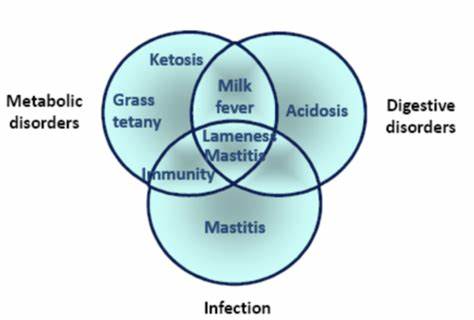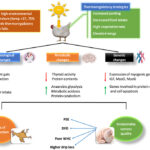
1. Introduction
Nutritional and metabolic disorders in ruminants occur when the balance of nutrients, energy, or metabolic processes is disrupted due to poor feeding practices, imbalanced rations, or physiological stresses (e.g., calving, peak lactation). These disorders not only reduce productivity (milk, meat, reproduction) but also lead to health complications and economic losses.
2. Common Nutritional and Metabolic Disorders
A. Ruminal Acidosis
Cause: Excessive intake of rapidly fermentable carbohydrates (e.g., grains) with insufficient fiber
Mechanism: Rapid fermentation → Accumulation of lactic acid → Drop in rumen pH (<5.5)
Signs:
- Decreased feed intake
- Diarrhea (often foamy)
- Lethargy and dehydration
- Poor milk production
- Laminitis (chronic cases)
Prevention & Management:
- Include adequate fiber (forage) in the diet
- Avoid sudden diet changes
- Use buffers (e.g., sodium bicarbonate)
- Feed ionophores (e.g., monensin) to regulate fermentation
B. Ketosis (Acetonemia)
Cause: Negative energy balance during early lactation → Mobilization of body fat
Mechanism: Excess fat mobilization → Liver converts fat to ketone bodies → Ketone accumulation in blood
Signs:
- Reduced milk yield
- Loss of appetite, especially for concentrates
- Sweet or acetone smell in breath, milk, or urine
- Nervous signs (in advanced cases)
Prevention & Management:
- Provide high-energy diets during transition and early lactation
- Use propylene glycol as a glucose precursor
- Monitor body condition score (BCS)
- Avoid overconditioning during late pregnancy
C. Milk Fever (Hypocalcemia)
Cause: Sudden drop in blood calcium levels around calving due to high demand for milk production
Mechanism: Inadequate calcium mobilization from bones
Signs:
- Muscle tremors
- Cold ears, dullness
- Recumbency (lying down, unable to rise)
- Coma and death if untreated
Prevention & Management:
- Feed low-calcium diets 2–3 weeks before calving
- Supplement anionic salts to improve calcium mobilization
- Give oral or intravenous calcium around calving
- Monitor high-risk cows closely
D. Grass Tetany (Hypomagnesemia)
Cause: Low magnesium intake or absorption, especially in lush, fast-growing pasture
Mechanism: Magnesium is essential for nerve and muscle function
Signs:
- Muscle twitching
- Nervousness or aggression
- Collapse, convulsions
- Sudden death (in severe cases)
Prevention & Management:
- Supplement magnesium (Mg oxide) in feed or mineral blocks
- Avoid grazing cows on lush pastures without magnesium supplementation
- Monitor weather changes (cold, wet weather increases risk)
E. Bloat (Ruminal Tympany)
Types:
- Frothy Bloat – gas trapped in stable foam (often from lush legumes like alfalfa)
- Free Gas Bloat – gas trapped due to esophageal blockage or motility issues
Signs:
- Swollen left abdomen
- Discomfort and kicking at belly
- Difficulty breathing
- Collapse and death (if untreated)
Prevention & Management:
- Avoid sudden access to lush legumes or high-concentrate diets
- Use anti-foaming agents (e.g., poloxalene)
- Provide roughage with legumes
- In emergencies: stomach tube or trocarization
F. Nutritional Diarrhea
Cause: Poor-quality feed, abrupt diet changes, high-fat or high-protein feed
Signs:
- Loose, watery feces
- Dehydration
- Poor growth
Prevention & Management:
- Introduce new feeds gradually
- Provide clean water and electrolytes
- Use probiotics and good-quality feed ingredients
G. White Muscle Disease (Nutritional Myopathy)
Cause: Selenium and/or Vitamin E deficiency
Primarily affects: Young calves and lambs
Signs:
- Muscle weakness or stiffness
- Inability to stand or suckle
- Sudden death (heart muscle involvement)
Prevention & Management:
- Supplement selenium and vitamin E in pregnant dam’s diet
- Inject vitamin E–selenium to newborns in deficient areas
- Monitor selenium levels in soil and feed
H. Urinary Calculi (Urolithiasis)
Cause: Imbalance in calcium to phosphorus ratio; high-concentrate diets in males (especially goats, sheep)
Signs:
- Straining to urinate
- Dribbling urine or blood-tinged urine
- Restlessness and abdominal discomfort
Prevention & Management:
- Maintain Ca:P ratio of 2:1
- Provide access to clean water
- Add ammonium chloride to acidify urine
- Ensure salt intake to increase water consumption
I. Copper Toxicity or Deficiency
Cause: Imbalance in copper intake, interactions with molybdenum or sulfur
Signs (Deficiency):
- Anemia, dull coat, infertility, bone disorders
Signs (Toxicity):
- Liver damage, jaundice, hemoglobinuria
Prevention:
- Monitor and adjust trace mineral supplementation carefully
- Avoid feeding feeds high in antagonistic minerals (e.g., high sulfur)
J. Lactic Acidosis in Calves
Cause: Overfeeding milk or milk replacer; carbohydrate-rich starter
Signs:
- Diarrhea with undigested milk
- Lethargy, dehydration
Prevention & Management:
- Feed appropriate volumes of milk
- Ensure access to clean starter and water
- Use probiotics to stabilize gut flora
3. General Prevention Strategies for Nutritional Disorders
- Balanced feeding: Follow NRC or region-specific guidelines for nutrient requirements.
- Gradual feed changes: Prevent rumen upset from sudden dietary transitions.
- Regular monitoring: Body condition scoring, milk yield, blood/urine tests.
- Feed testing: Analyze forages and TMR for nutrient composition and mycotoxins.
- Supplementation: Provide minerals and vitamins tailored to the production stage.
- Training of staff and farmers: Nutrition awareness, early detection, and proper management.
4. Economic Impact
- Reduced milk/meat yield
- Higher treatment and veterinary costs
- Reproductive failures and increased culling
- Mortality in severe cases
Preventing these disorders through sound nutritional planning and management is far more economical and sustainable than treating them after they occur.
5. Conclusion
Nutritional and metabolic disorders are a major concern in modern ruminant production systems. They can be largely prevented by:
- Formulating balanced rations
- Monitoring animal health and behavior
- Adjusting feed as per physiological stage and environmental stress
With routine veterinary oversight, nutritional audits, and farmer education, the incidence of these disorders can be minimized, ensuring better animal welfare and profitability.




23-CUVAS-0315
Reg# 23-CUVAS-0315
Saima sehar
Reg no: 23-cuvas-0320
DVM 4th semester
Reg# 23-CUVAS-0315
Saima sehar
Reg no: 23-cuvas-0320
DVM 4th semester
23-CUVAS-0318
23-cuvas-0314
23-cuvas-0300
Laiba Hafeez
Reg no : 23-cuvas-0298
DVM 4th semester
Good
Reg # 23-cuvas-0314
23-CUVAS-0337
DVM (4th semester)
Reg. No. 23-cuvas-0308
Reg # 23-cuvas-0314
23-CUVAS-0337
DVM (4th semester)
23-cuvas-0336
23-Cuvas-0617
Reading
Reg#:23-CUVAS-0312
DVM 4TH
Reading
Muhammad sheraz
Registration no: 23-cuvas-0310
Preetam Raam
23-CUVAS-0334
DVM 4th
Amazing
Rg no : 23-CUVAS-0325
0291
23-cuvas-0300
23-Cuvas-0332 Awesome learning platform
Abdullah Sharif 23-Cuvas-0332 DVM 4th semester
Abdullah Sharif 23-Cuvas-0332
Rg no : 23-CUVAS-0325
Laiba Hafeez
Reg no : 23-cuvas-0298
23-CUVAS-0325
Rg no : 23-CUVAS-0325